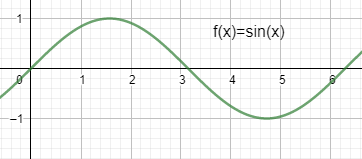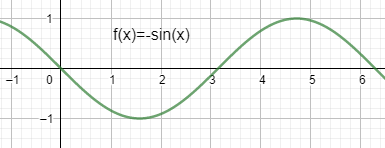
How do you graph the derivative of $f(x)=\cos (x)$?
Answer
540.3k+ views
Hint: In this question we will first find the derivative of the given function $f(x)$ which is equal to $\cos (x)$. We will take the derivative of the function using the formula $\dfrac{d}{dx}\cos (x)=-\sin (x)$, and then simplify the expression and plot the graph for the resultant function.
Complete step-by-step solution:
We have the given function as $f(x)=\cos (x)$. Now we have to find the derivative of the function. The derivative of the function can be taken as:
$\Rightarrow \dfrac{d}{dx}\cos (x)$
Now we know that $\dfrac{d}{dx}\cos (x)=-\sin (x)$ therefore, on using the formula in the above expression, we get:
$\Rightarrow -\sin (x)$, which is the required derivative of the function therefore, we can write it as:
$f'(x)=-\sin (x)$
Now we know the $\sin (x)$ graph starts from the origin and goes upwards and then goes downwards from the value of $\pi $ and then goes upwards again and reaches the value of $0$ again after $\pi $. It can be plotted as:

Now in this question we have to plot the graph of $-\sin (x)$. Since it is the negative graph of $\sin (x)$, the graph will have all the same values but it will be inverted. It can be plotted as:

Which is the required solution.
Note: The general format of the $\sin (x)$ function should be remembered as $y=a\sin (bx+c)+d$
Where $a$ is the amplitude of the equation which tells us the maximum and the minimum value the graph would go from the base line value,
$b$ is the period of the graph,
$c$ depicts the shift of the equation, positive shift represents that the graph is shifted towards the left and negative shift represents the graph shifting to right.
And $d$ is the baseline of the equation which tells us whether the graph is going upwards or downwards.
Complete step-by-step solution:
We have the given function as $f(x)=\cos (x)$. Now we have to find the derivative of the function. The derivative of the function can be taken as:
$\Rightarrow \dfrac{d}{dx}\cos (x)$
Now we know that $\dfrac{d}{dx}\cos (x)=-\sin (x)$ therefore, on using the formula in the above expression, we get:
$\Rightarrow -\sin (x)$, which is the required derivative of the function therefore, we can write it as:
$f'(x)=-\sin (x)$
Now we know the $\sin (x)$ graph starts from the origin and goes upwards and then goes downwards from the value of $\pi $ and then goes upwards again and reaches the value of $0$ again after $\pi $. It can be plotted as:

Now in this question we have to plot the graph of $-\sin (x)$. Since it is the negative graph of $\sin (x)$, the graph will have all the same values but it will be inverted. It can be plotted as:

Which is the required solution.
Note: The general format of the $\sin (x)$ function should be remembered as $y=a\sin (bx+c)+d$
Where $a$ is the amplitude of the equation which tells us the maximum and the minimum value the graph would go from the base line value,
$b$ is the period of the graph,
$c$ depicts the shift of the equation, positive shift represents that the graph is shifted towards the left and negative shift represents the graph shifting to right.
And $d$ is the baseline of the equation which tells us whether the graph is going upwards or downwards.
Recently Updated Pages
A man running at a speed 5 ms is viewed in the side class 12 physics CBSE

The number of solutions in x in 02pi for which sqrt class 12 maths CBSE

State and explain Hardy Weinbergs Principle class 12 biology CBSE

Write any two methods of preparation of phenol Give class 12 chemistry CBSE

Which of the following statements is wrong a Amnion class 12 biology CBSE

Differentiate between action potential and resting class 12 biology CBSE

Trending doubts
What are the major means of transport Explain each class 12 social science CBSE

Which are the Top 10 Largest Countries of the World?

Draw a labelled sketch of the human eye class 12 physics CBSE

Explain sex determination in humans with line diag class 12 biology CBSE

Explain sex determination in humans with the help of class 12 biology CBSE

Differentiate between homogeneous and heterogeneous class 12 chemistry CBSE




